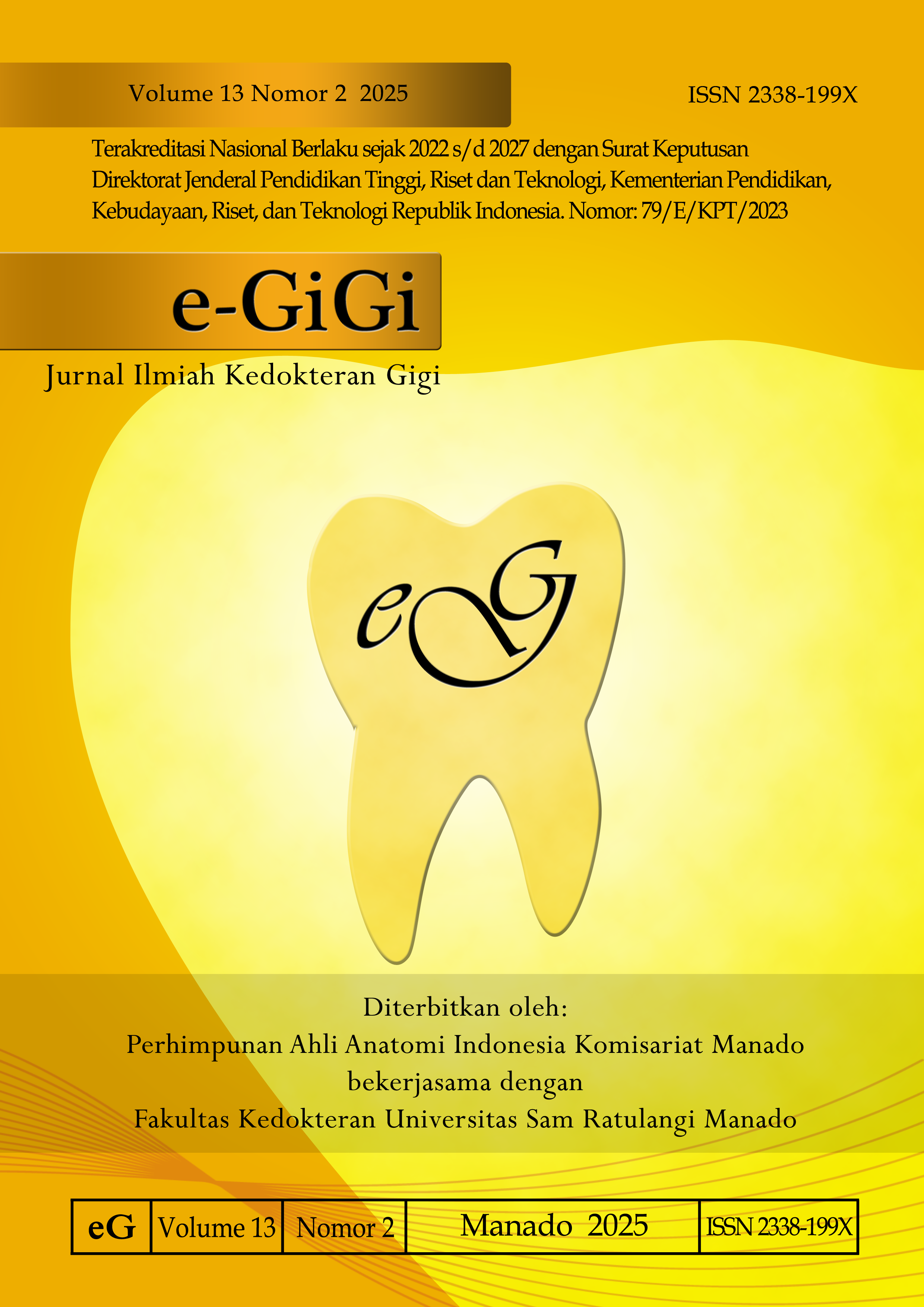Gambaran Tingkat Pengetahuan Mengenai Kebersihan Gigi dan Mulut pada Siswa Pengguna Perangkat Ortodonti Cekat
DOI:
https://doi.org/10.35790/eg.v13i2.59561Abstract
Abstract: One of the risks of using braces is the increase in dental caries and periodontal diseases. Knowledge of oral dental hygiene is needed so that users of orthodontic devices can properly maintain and maintain oral dental hygiene. This study aimed to obtain the description of the level of oral hygiene knowledge among senior high school students who used fixed orthodontic devices. This was a descriptive st udy with a cross-sectional design. Samples consisted of 30 students of SMA Katolik Rex Mundi and SMA Eben Haezar (high schools) in grades 10−12 with fixed orthodontics, obtained by using the total sampling technique. The results showed that 28 respondents (93.3%) had good level of knowledge about dental and oral health, and two respondents (6.7%) had fair level of knowledge. One female respondent (4.4%) had fair level of knowledge and 22 respondent (95.6%) had good level of knowledge. One male respondent (14.2%) had fair level of knowledge and six respondents (85.8%) had good level of knowledge. In conclusion, most students of SMA Katolik Rex Mundi and SMA Eben Haezar using fixed orthodontic devices regarding oral dental hygiene have good level of knowledge.
Keywords: fixed orthodontics; knowledge level; students using fixed orthodontics
Abstrak: Salah satu risiko pemakaian kawat gigi yaitu meningkatnya karies gigi dan penyakit periodontal. Pengetahuan tentang kebersihan gigi mulut diperlukan agar pengguna perangkat ortodonti dapat menjaga dan memelihara kebersihan gigi mulut dengan benar. Penelitian ini bertujuan untuk mengetahui gambaran tingkat pengetahuan kebersihan gigi mulut pada siswa-siswi SMA Katolik Rex Mundi dan SMA Eben Haezar pengguna perangkat ortodonti cekat. Jenis penelitian ialah deskriptif dengan desain potong lintang. Sampel penelitian berjumlah 30 siswa kelas 10−12 pengguna ortodonti cekat yang diambil menggunakan teknik total sampling. Hasil penelitian mendapatkan 28 responden (93,3%) memiliki tingkat pengetahuan kebersihan gigi mulut yang baik, dan dua responden (6,7%) memiliki tingkat pengetahuan yang cukup. Responden berjenis kelamin perempuan sebanyak satu siswa (4,4%) memiliki tingkat pengetahuan cukup dan sebanyak 22 siswa (95,6%) yang memiliki tingkat pengetahuan baik. Responden berjenis kelamin laki-laki sebanyak satu siswa (14,2%) memiliki tingkat pengetahuan cukup dan sebanyak enam siswa (85,8%) memiliki tingkat pengetahuan baik. Simpulan penelitian ini ialah tingkat pengetahuan mayoritas siswa SMA Rex Mundi dan SMA Eben Haezar pengguna perangkat ortodonti cekat mengenai kebersihan gigi mulut dalam kategori baik.
Kata kunci: ortodonti cekat; tingkat pengetahuan; siswa pengguna perangkat ortodonti cekat
References
Momongan REC, Lampus BS, Juliatri. Status kebersihan gigi dan mulut siswa SMA Negeri 9 Manado pengguna perangkat ortodontik cekat. e-GiGi. 2016;5(1):2302−493. Doi: doi.org/10.35790/eg.3.1.2015.6409
Badan Penelitian dan Pengembangan Kesehatan. Riset Kesehatan Dasar. Jakarta: Departemen Kesehatan Republik Indonesia, 2007; p. 130.
Badan Penelitian dan Pengembangan Kesehatan. Riset Kesehatan Dasar. Jakarta: Departemen Kesehatan Republik Indonesia, 2013; p. 110.
Badan Penelitian dan Pengembangan Kesehatan. Riset Kesehatan Dasar. Jakarta: Departemen Kesehatan Republik Indonesia, 2018; p. 182−95.
Laguhi VA, Gunawan PN, Anindita PS. Gambaran maloklusi dengan menggunakan HMAR pada pasien di Rumah Sakit Gigi dan Mulut Universitas Sam Ratulangi Manado. e-GiGi. 2014;2(2):1-7. Doi: https://doi.org/10.35790/eg.2.2.2014.5829
Zhang M, McGrath C, Hägg, U. The impact of malocclusion and its treatment on quality of life: a literature review. Int J Paediatric Dent. 2006;16:381−7. Doi: 10.1111/j.1365-263X.2006.00768.x
Atassi F, Awartani F. Oral hygiene status among orthodontic patients. Journal of Contemporary Dental Practice. 2010;11(4):25−32. Available fom: https://pubmed.ncbi.nlm.nih.gov/20953561/
Mararu WP, Zuliari K, Mintjelungan CN. Gambaran status kebersihan gigi dan mulut pada pengguna perangkat ortodontik cekat di SMA Negeri 7 Manado. e-GiGi. 2017;5(2):159−65. Doi: https://doi.org/10.35790/ eg.5.2.2017.17128
Suci RA, Saputri D, Sungkar S. Gambaran tingkat pengetahuan kebersihan mulut pada siswa sekolah menengah atas yang menggunakan perangkat orthodonti. Journal Caninus Dentistry. 2016;1(4):20−5. Available from: https://jim.usk.ac.id/JCD/article/viewFile/1658/861
Wijanarko CI, Handoko SA, Hutomo LC. Tingkat pengetahuan dan perilaku terhadap status kebersihan gigi dan mulut pengguna piranti ortodontik cekat pada mahasiswa Fakultas Kedokteran Universitas Udayana. Bali Dental Journal. 2020;4(1):37−43. Doi: https://doi.org/10.51559/bdj.v4i1.243
Rambitan WKD, Anindita PS, Mintjelungan CN. Hubungan pemakaian perangkat ortodonti cekat dengan status kebersihan gigi dan mulut siswa SMA Kristen 1 Tomohon. e-GiGi. 2019;7(1):23-9. Doi: https://doi.org/10.35790/eg.7.1.2019.23309
Rahayu SA. Pengantar Kebijakan Fiskal. Jakarta: Bumi Aksara; 2010. p. 2−4.
Notoadmojo S. Promosi Kesehatan dan Ilmu Perilaku. Jakarta: Rineka Cipta; 2007. p. 140.
Al-Silwadi FM, Gill DS, Petrie A, Cunningham SJ. Effect of social media in improving knowledge among patients having fixed appliance orthodontic treatment: A single-center randomized controlled trial. Am J Orthod Dentofacial Orthop. 2015;148(2):231-7. Doi: 10.1016/j.ajodo.2015.03.029
Walsh LJ, Healey DL. Prevention and caries risk management in teenage and orthodontic patients. 2019. Aus Dent J. 2019;64(1):37−45. Doi: 10.1111/adj.12671
Newton JT, Asimakopoulou K. Minimally invasive dentistry: enhancing oral health related behaviour through behaviour change techniques. Br Dent J. 2017;223(3):147−50. Doi: 10.1038/sj.bdj.2017.659
Samsul AR, Praptiwi YH, Putri MH, Sirait T. Hubungan tingkat pengetahuan kesehatan gigi terhadap sikat untuk menjaga kebersihan gigi pada siswa di SMA Negeri 1 Kawali. JKGM. 2021;3(2):36−4. Doi: https://doi.org/10.36086/jkgm.v3i2.843
Downloads
Published
How to Cite
Issue
Section
License
Copyright (c) 2025 Briyando E. Sumilat, Pritartha S. Anindita, Johanna A. Khoman

This work is licensed under a Creative Commons Attribution-NonCommercial 4.0 International License.
COPYRIGHT
Authors who publish with this journal agree to the following terms:
Authors hold their copyright and grant this journal the privilege of first publication, with the work simultaneously licensed under a Creative Commons Attribution License that permits others to impart the work with an acknowledgment of the work's origin and initial publication by this journal.
Authors can enter into separate or additional contractual arrangements for the non-exclusive distribution of the journal's published version of the work (for example, post it to an institutional repository or publish it in a book), with an acknowledgment of its underlying publication in this journal.
Authors are permitted and encouraged to post their work online (for example, in institutional repositories or on their website) as it can lead to productive exchanges, as well as earlier and greater citation of the published work (See The Effect of Open Access).






